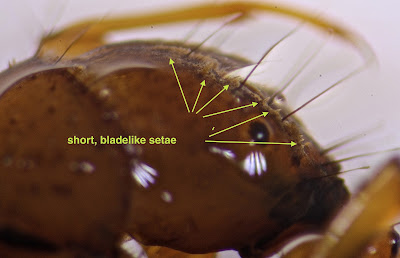Friday, September 14, 2012
Pycnopsyche gentilis and Pycnopsyche scabripennis: Identifying Two of the Northern Case-makers (Limnephilids) We Find in Our Streams
When I started this project, I shied away from genus level ID of Limnephilid (Northern Case-maker caddisflies) larvae (see the entry for 1/18/11). But as I became more adept at microscope work, I came to recognize the dark sclerite at the back of the lateral humps that indicate a Pycnopsyche genus ID.
I now think that almost every -- if not every -- Limnephilid I've found is Pycnopsyche in genus. I've been hesitant to go beyond that to species level ID. But this week, as I was sorting through the insect articles, print-outs, e-mails, etc. that I've collected since I started this blog, I came across a "Key to the Last Instar Larvae of the genus Pycnopsyche." I no longer remember where I found this, but the key is abstracted from John A. Wojtowicz's doctoral dissertation -- "A review of the adults and larvae of the genus Pycnopsyche (Trichoptera: Limnephilidae) with revision of the Pycnopsyche scabripennis (Rambur) and Pycnopsyche lepida (Hagen) complexes" (Univ. of Tenn., 1982). Why not give species identification a try?
I've been able to identify two of the Limnephilids that I've found this year and last year. The first -- the one in the photo at the top of the page -- is Pycnopsyche gentilis.
1. Pycnopsyche gentilis. P. gentilis is one of the Northern case-makers that initially builds a three-sided case out of fragments of leaves but switches to a more substantial mineral case as it matures. Thus, in the early months of winter (January -- March), their cases look like this:
and this:
But later on (April/May), the cases are made out of pebbles and sand.
The neat thing with the case at the top of the page is that it's a mixture of both building materials. Remember that with the exception of Saddle case-makers, case making caddisfly larvae do not abandon their cases as they mature: they simply add material to the front of the case.
All of the P. gentilis larvae I've found have been in small tributaries to the Moormans in Sugar Hollow. They prefer tiny, mountain streams, densely forested, streams in which they have easy access to the leaves that they use. They're also in "head water" streams where they are major "shredders" of leaves at the start of the food chain.
Let's key this out, using the work of Wojtowicz.
1a. Many head setae short and bladelike in area in front of eye, and behind and above eye and extending toward occiput; case cylindrical and composed of rock fragments in last instar, but often leaf-case with triangular cross section in early instars... 2
1b. All setae in area in front of eye, and above and behind eye slender and hair-like ... 3
Here's a microscope view of the larva at the top of the page: the setae are "short and bladelike," and our cases match this description exactly.
So we move on to 2. 2a. Dorsal spacing hump completely absent ... Pycnopsyche gentilis
Our larva does have lateral humps, but the dorsal hump is missing. Pycnopsyche gentilis.
Let me note one other thing on this species from Steven Beaty's "The Trichoptera of North Carolina," p. 84. In discussing P. flavata larvae Beaty says: "Found in headwater areas in the mountains in slow moving and shallow spring ares. Often occur with P. gentilis." And those are the kinds of streams where I find them.
Oh. The larva in the photo at the top of the page was 20 mm long; the case was 35 mm.
____________________
2. Pycnopsyche scabripennis. These are the big larvae that I find in the Rapidan River.
5/4/11:
and 5/9/12
The larva in the first case was 24 mm; that in the second case, 25 mm. That's big!
In Wojtowicz's key, we get to this species when we start with 2b: "Dorsal spacing hump present." It is.
We move to 3a. and 3b.
3a. Three or more major setae on ventral margin of hind femur...4
3b. Only two major setae on ventral margin of hind femur...5
Our larvae only have two major setae in that location. This requires a microscope view.
5a. Case mostly mineral ... P. lepida
No.
5b. Case of vegetable matter... P. scabripennis.
Yes. That's what we have.
Beaty ("The Trichoptera...," p. 85) adds one more feature for us to check on this species. "venter of first abdominal segment with less than 15 setae." I could only manage a photo of one side of the abdominal segment. I see 7 major setae.
_________________
So, we at least know the names of two of the Pycnopsyches we find. There are others, and I'll work on them when I can.
Pycnopsyches in general, by the way, are important for fly fisherman (a 25 mm larva must be a tempting treat for the trout, and it produces a sizable adult: the "Great brown autumn sedge"). Thomas Ames (Caddisflies, p. 252) makes the following observations: "Pycnopsyche larvae get their nickname, stick caddis or stick bait, from their shelters of twigs and stems arranged most commonly in roughly linear fashion. In the spring the larvae are everywhere, from tiny rivulets to small rivers. Their abundance in northern freestone streams, and the opportunities of catching large and hungry fish on cased imitations, cannot be overstated." Yes, there are "flies" that imitate cases, and yes, the trout will eat them cases and all!
___________________
Next up -- which species is this?
Subscribe to:
Post Comments (Atom)















hellooooooooooooooooooooooooooooooooooooooooooooooooooooooooooooooooooooooooooooooooooooooooooooooooooooooooooooooooooooooooooooooooooooooooooooooooooooooooooooooooooooooooooooooooooooooooooooooooooooooooooooooooooooooooooooooooooooooooooooooooooooooooo this is uslles
ReplyDeleteHello! I just apparently found a Pycnopsyches adult shot a photo and INaturalist scientists identified it to genus. Would you be able to tell me what species? I don’t think I can post a photo here? Located in the floodplain of the Schuylkill River
ReplyDeletee1p69e3k54 x2a16u0p84 d8r25y0p08 z7n23s2d87 b8n41r9p65 f0e53b3j21
ReplyDelete